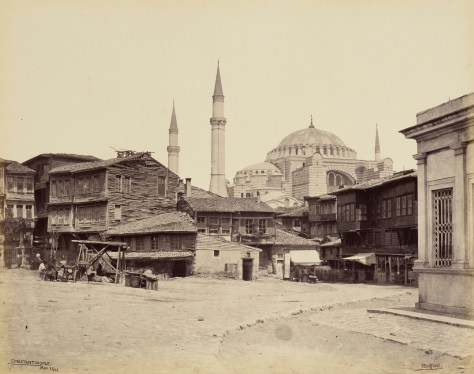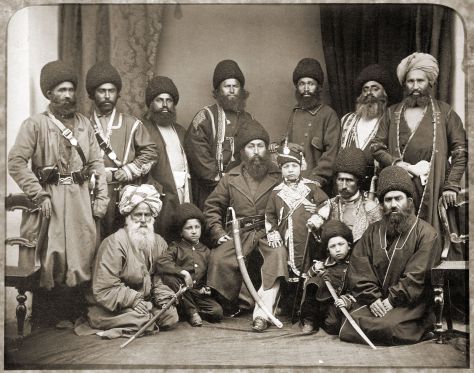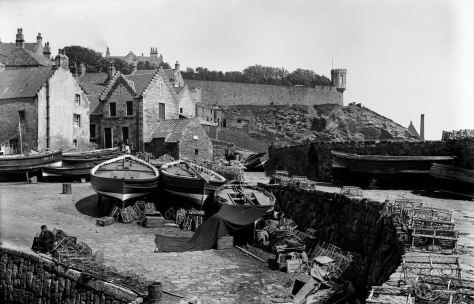Victorian and early 20th Century travels.
Journeys and travelling have been associated with photography from its very early days, well before Jack Kerouac’s work On the Road was conceived. In the Victorian era it was common to take a Grand Tour, and not unusual for the tour to be accompanied by a photographer.
One of the most famous of the tours was that of Queen Victoria’s son, the future King Edward VII. He took a major journey around the Middle East and was a accompanied by the photographer Francis Bedford (1815-1984). A book of images from this tour has recently been published Cairo to Constantinople (Gordon et al., 2013) which shows many of the images accompanied by a travelogue and short excerpts from the Prince of Wales diary. One typical example shows the mosque Hagia Sophia alongside the comment, [the Prince thought Hagia Sophia] ‘the finestI have seen in the East. It was formerly a Xtian church’ (p.199). It is interspersed with maps showing the journey and gives a real feel for how the wealthy English found the Middle East in that era. Some of the pictures include people, although, unless famous they are rarely the focus of the image and may well have been included simply to show the massive scale of the monuments. On return to England the pictures were made into a portfolio produced by Day & Son and were also published more widely. This was definitely a commercial venture by Bedford, given extra kudos by the presence of the Prince.

John Burke (1843 – 1900) traveled widely in Afghanistan where he took many images of the British forces during one of their earlier invasions of that land. Burke took pictures of the landscape, (devastated by war), some rather beautiful images of the countryside and portraits, both of the English soldiers and the local people. In From Kashmir to Kabul (Khan, 2002) Khan shows many of the images but also points out the the attribution of many of the images is unclear as another photographer, William Baker, was his partner and they published (and sold) images jointly as Baker & Burke. The images have recently seen recreated in spirit by Simon Norfolk in Burke and Norfolk (Burke and Norfolk, 2011) where he returned to Afghanistan in 2010 in a plan to respond to Burke’s Images. There is a fascinating interview between Norfolk and Paul Lowe which explains his aims in detail (Lowe, and Norfolk, s.d.).

Francis Frith (1822-1895) also travelled widely abroad across the Middle East but his main focus was Great Britain. His plan was to take accurate records of as many of the towns in Great Britain as possible, and then sell them to people looking for souvenirs. Although he took many images himself, he also employed a team of people to both take some of the images and to sell them. His work was continued after his death by his family and has now been formed into the Francis Frith Archive (Francis Frith: Old Photos, Maps, Books and Gifts, s.d.).

More locally to me, Erskine Beveridge (1851-1920) who was an industrialist and an amateur photographer/historian travelled widely in Scotland, documenting the building as and the people. It is surprising how little many of the places have changed over 100 years. He succeeded in his wanderings of building up a record of the places and both the important historical and domestic architecture. See Wanderings with A Camera in Scotland (Beveridge and Ferguson, 2009) for a record of his images.

Although all these early photographers travelled widely and took many photographs, it seems likely that for many of them this was their business. It is difficult to know now how much they were inspired by the love of exploring rather than the needs of the business. One exception to this may have been John Thomson (1837 – 1921) who travelled in China and was fascinated by the place and the culture, taking images of both scenery and the people.

Travel in this period was difficult, expensive and the cameras were all large, heavy, and cumbersome. They all initially used wet collodion plates, which needed to be developed immediately, and even when that technology moved on, glass plates were fragile, and many were broken in transit. In reality, it is surprising that we have as wide an archive of the early photographers travels as we do.
Unlike later photographers these images are about the specific place. They are rarely loaded with emotion. They tell a story, but it is limited. It says, “I went there”, “I did that”, “I met those people (usually the well-off)”. They showed the strange and different, the things that would excite the people who had never travelled. The images that would sell. And the images that would make their names by being included in important research publications such as those of The Royal Geographical Society. The Victorians and early 20th century population had just started to travel en masse. It was no longer kept to the very rich. They wanted to see where they might go. They wanted souvenirs. They liked the picturesque. Catering to this need was the reason many of these images were made. Nowadays, they are historically interesting. The changes over time are important to see. Sometimes, like the `Burke images of war in Afghanistan they give a frightening view of how things have not changed. But they come from a different mindset and type of photography than the journeys that are taken now.
References:
Beveridge, E. and Ferguson, L. M. (2009) Wanderings with a camera in Scotland: the photography of Erskine Beveridge. Edinburgh: RCAHMS.
Burke, J. and Norfolk, S. (2011) Burke + Norfolk: photographs from the war in Afghanistan by John Burke and Simon Norfolk. Stockport: Dewi Lewis Publ.
Francis Frith: Old Photos, Maps, Books and Gifts (s.d.) At: https://www.francisfrith.com/uk/ (Accessed 22/07/2020).
Gordon, S. et al. (2013) Cairo to Constantinople: Francis Bedford’s photographs of the Middle East. London: Royal Collection Trust.
Khan, O. (2002) From Kashmir to Kabul: the photographs of John Burke and William Baker 1860-1900. Munich: Prestel.
Lowe, P. and Norfolk, S. (s.d.) Burke + Norfolk – In conversation. At: https://www.simonnorfolk.com/burkenorfolk/conversation.html (Accessed 22/07/2020).
